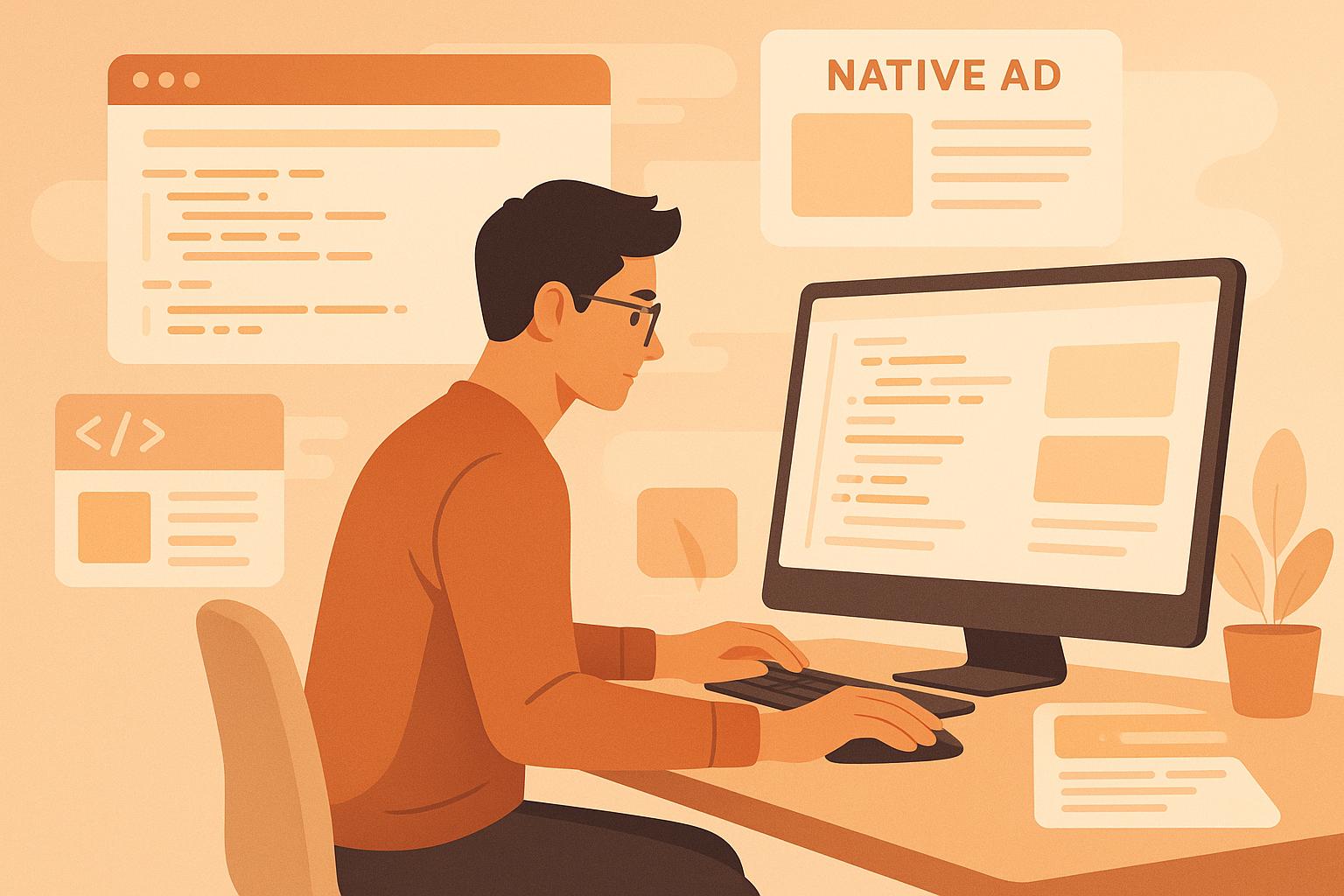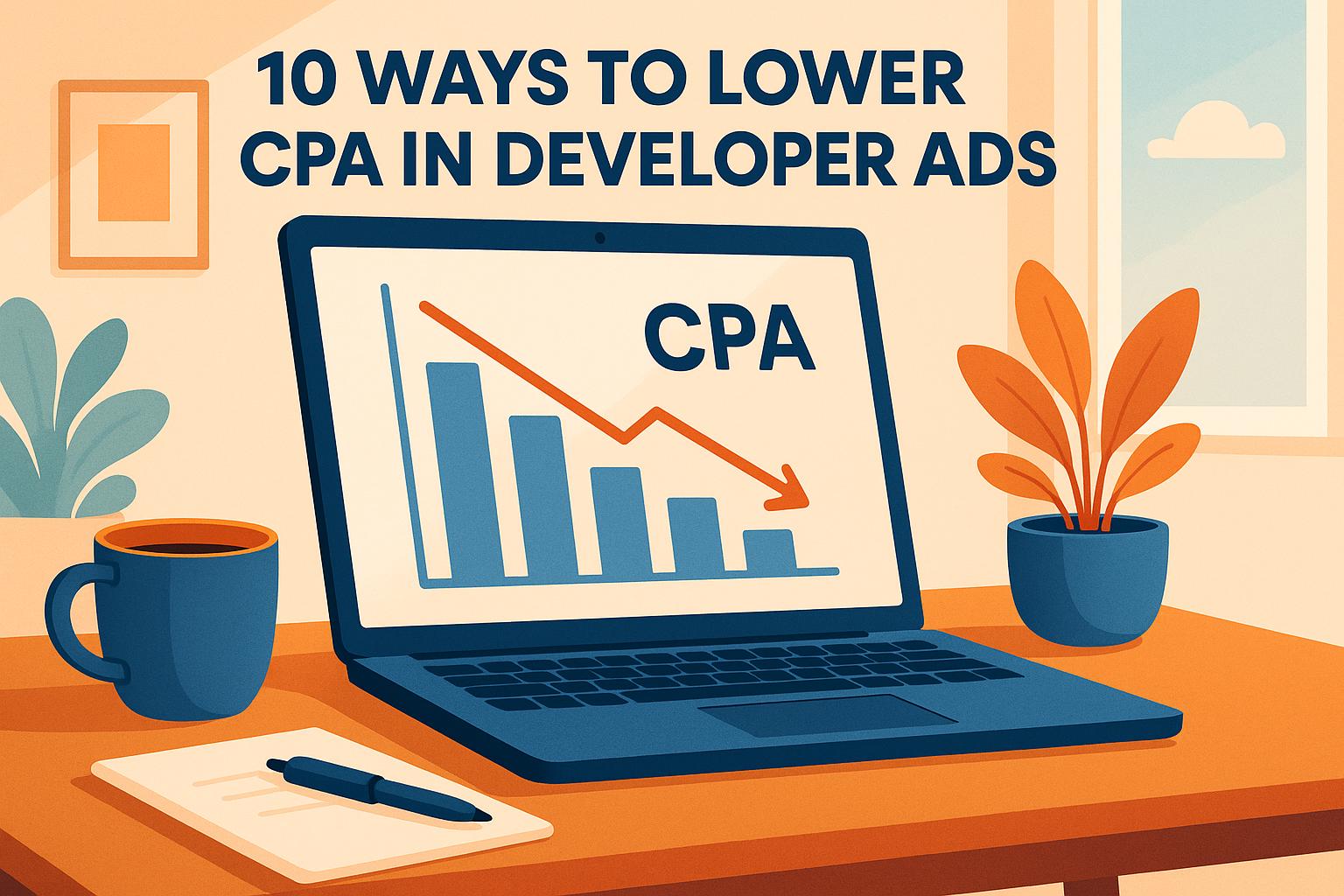


Improve your follow-up strategy to engage developers effectively by personalizing outreach and leveraging the right channels and timing.
You’ve done the hard part: getting developers’ attention. But here’s the harsh truth - most of that initial interest is going to waste because your follow-up strategy isn’t working. The problem? Weak follow-ups lead to missed opportunities, wasted marketing budgets, and lost credibility.
Here’s what you need to know:
- Developers hate generic, sales-heavy follow-ups. They want technical, problem-solving content that aligns with their needs.
- Timing matters. Leads contacted within 5 minutes are 100x more likely to convert than those reached after 30 minutes.
- Persistence is key. 80% of sales require at least 5 follow-ups, yet almost half of companies give up after one.
- Developers live on platforms like GitHub, Stack Overflow, and Discord. If you’re relying only on email, you’re missing them.
The solution? Personalize your outreach, deliver technical value, and use tools like AI-driven email platforms or daily.dev Ads to meet developers where they are. A strong follow-up strategy isn’t just about closing deals - it’s about building trust and turning interest into long-term engagement.
Selling to Developers Needs a Different Approach
Common Developer Follow-Up Mistakes
Traditional B2B follow-up strategies often fall flat when aimed at developers. Why? Because developers have distinct communication preferences and expectations that differ from the typical business buyer.
Generic Messages That Miss the Mark
One of the biggest missteps is sending follow-ups that feel like they were churned out by a machine. Developers can spot a generic email instantly, and when they do, it’s either ignored or deleted.
"Can you spot a generic email from a mile away? So can your clients. If your follow-up feels like it's sent to a list of 100 people, that's exactly how it's going to get treated."
- Patricija Šobak
The problem gets worse when these messages fail to address a developer's specific needs or reference prior interactions. For instance, if a developer requested an SDK for mobile apps, but your follow-up talks about web APIs, you've just lost a valuable opportunity to connect. Similarly, if someone attended your webinar on microservices architecture, your follow-up should reflect key points from that session - not rehash product basics they likely already know.
To stand out, your follow-ups need to offer relevant technical insights or tackle specific challenges developers face. Anything less risks being dismissed as noise.
Using Sales Tactics That Backfire
Taking a pushy, sales-heavy approach can do more harm than good. Aggressive language and forced urgency often alienate developers, who value authenticity and technical depth over a hard sell.
While persistence is necessary - 80% of sales require an average of five follow-ups to close, and 50% of deals happen after the fifth attempt - many companies miss the mark by rushing the process. Developers need time to evaluate technical solutions, test integrations, and gain internal approval. High-pressure tactics contradict the careful, methodical approach developers prefer.
Another major misstep is ignoring available data. Failing to research a developer’s background, recent projects, or interests makes your follow-up appear irrelevant and out of touch. Developers expect you to understand their challenges before presenting solutions. And when companies delay responding to technical inquiries, they risk losing the chance to connect while the developer is actively seeking answers.
Missing Developers on Their Preferred Platforms
Even if your messaging is on point, sending it through the wrong channels can render your efforts invisible. Many companies rely solely on email for follow-ups, but developers spend much of their time on other platforms. Developers research tools, ask questions, and seek validation on forums, chat apps, and social media.
Platforms like GitHub, Stack Overflow, Discord, Slack, and other technical forums are where developers naturally gather. Ignoring these spaces means missing a crucial opportunity to connect during their decision-making process.
Developers also value clear, factual information over sales pitches. They want access to real code examples, technical specs, and documentation that lets them evaluate solutions independently. Hands-on resources are far more effective than pushing for a meeting or sales call.
Community engagement is equally critical. Developers influence decision-makers and often drive technology adoption from the ground up. If they can’t find peer discussions, community support, or technical validation on trusted platforms, they’re likely to move on to competitors who offer a stronger presence.
The companies that succeed in developer follow-up meet developers where they already spend their time. This could mean participating in GitHub discussions, answering questions on Stack Overflow, or fostering active communities on Discord and Slack. By showing up in these spaces with valuable technical content, you position yourself as a trusted resource in their search for solutions.
Building a Developer-First Follow-Up Strategy
Creating an effective follow-up strategy for developers means stepping away from traditional B2B tactics. Instead, focus on delivering personalized, technical, and well-timed content that aligns with their deliberate decision-making process.
Using Data to Personalize Messages
The best developer follow-ups use AI to dig into lead profiles, funnel stages, and past interactions to craft messages that genuinely connect. This goes far beyond just adding a name to an email.
In November 2024, Clay.com shared how AI-driven email personalization doubled their campaign response rates. By analyzing lead data - like funnel position and communication history - the AI identified the best value proposition for each lead.
"When used properly in outbound sales, AI can generate email content for you and personalize it for each lead at lightning speed. We've used it in our own email campaigns and seen doubled response rates!" - Clay Team
Understanding a developer’s technical background and specific challenges is key. For example, if someone downloads your Python SDK documentation, follow up with a technical tip or an advanced use case tailored to Python. AI can even anticipate concerns or questions based on user demographics, engagement history, and lead scoring.
Dynamic content blocks take this personalization further by adapting email content to include relevant code samples, documentation links, or case studies based on factors like the recipient’s programming language or industry. AI can also tweak the tone of your emails to match the recipient’s social media style or professional norms, making the communication feel natural and engaging.
Once you’ve nailed personalization, the next step is figuring out the best timing to reach developers.
Getting Timing and Frequency Right
Developers don’t follow the usual sales cycle. They often research during off-hours, dive into documentation over weekends, and make decisions based on technical evaluations rather than sales pitches.
To stay on their radar, follow up within 24 to 48 hours after initial contact. This keeps your solution fresh in their minds. Be persistent - most follow-ups require at least five touches before getting a response.
A good follow-up schedule might look like this: an initial email within 24–48 hours, followed by additional touches at 3–4 days, 7 days, 14 days, and 30 days. Each interaction should offer increasing technical value.
For example, XYZ Corporation, a SaaS provider, revamped their follow-up timing by analyzing user behavior and engagement. This led to a 40% boost in email responses and a 25% jump in conversions within the first 30 days.
The trick is balancing persistence with respect for a developer’s workflow. Don’t flood their inbox daily, but don’t disappear for weeks either. Use tools to track engagement and automate reminders while keeping your messages personal and relevant.
Once you’ve got the timing right, make sure your follow-ups deliver technical value that developers can use immediately.
Providing Technical Content That Adds Value
Developers don’t want sales fluff - they want actionable content that helps them solve problems or explore your solution hands-on.
Effective follow-ups include things like implementation guides, real-world code examples, and troubleshooting resources. Visual aids such as diagrams, screenshots, and code snippets can make complex ideas easier to grasp .
For instance, provide step-by-step instructions for integrations that developers can test in real time. Whenever possible, include real-life examples to make abstract concepts more relatable.
High-quality documentation is critical. Your follow-ups should link to clear and concise resources like API guides, SDK documentation, and troubleshooting FAQs tailored to the developer’s specific needs . Online help centers and knowledge bases can also offer quick solutions when developers hit a snag.
Before sharing technical content, test it yourself. Have someone unfamiliar with your product try to follow your documentation. This can highlight confusing areas and help you refine your materials. Additionally, feedback from developers who interact with your content can guide continuous improvements.
Positioning yourself as a technical ally - not just another vendor - builds trust and keeps developers engaged, increasing the chances they’ll adopt your solution.
Tools and Automation for Better Follow-Up
To turn initial interest into meaningful engagement, having the right tools can make all the difference. Automation tools, when used thoughtfully, can turn a manual follow-up process into a scalable system that still feels personal. The key is to focus on tools that prioritize genuine interactions rather than sheer volume, ensuring your communication with developers remains authentic and effective.
Automation Tools for Developer Outreach
Modern tools blend automation with personalization, making it easier to cater to developers' preferences for technical content and meaningful communication.
- Instantly.ai: With a G2 rating of 4.8/5 from over 3,500 reviews, Instantly.ai is a standout option. Their Growth plan, priced at $30/month, focuses on optimized email deliverability for cold outreach.
- Saleshandy: Starting at $25/month (billed annually), Saleshandy uses AI to simplify follow-ups, making it a strong choice for developer-focused campaigns.
- Reply.io: For teams needing a multi-channel approach, Reply.io offers automated engagement across email, LinkedIn, and calls. Starting at $49/month, it uses AI to trigger follow-ups based on developer interactions with your content.
- Apollo.io: At $49 per user per month, Apollo.io combines a powerful B2B database with cold email automation, helping you connect with developers who match your target profile.
Speed is critical in follow-up efforts. Companies that respond to leads within an hour are seven times more likely to engage decision-makers, while leads contacted within five minutes are 21 times more likely to qualify for further conversations. These numbers highlight why timely and efficient follow-up is so important in developer marketing.
Using daily.dev Ads for Targeted Follow-Up

daily.dev Ads provides a unique way to refine your follow-up strategy. By analyzing which technical topics and ad placements resonate with developers, the platform helps you create more tailored outreach. For example, if developers are engaging with Python-related content, you can follow up with messages featuring Python use cases or examples.
The platform also offers real-time performance tracking, showing you which tools, topics, and content formats drive the most engagement. This data allows you to segment your follow-up lists and create highly targeted sequences rather than sending out generic messages.
Another advantage of daily.dev Ads is its ability to reveal developers' engagement patterns. Insights like the times developers interact with your content or the topics that grab their attention can help you refine your approach. Since the platform operates within a trusted developer ecosystem, the leads you generate are already inclined toward technical conversations rather than generic sales pitches.
Tool Comparison: Features and Costs
Choosing the right tool depends on your budget, technical requirements, and the level of integration you need. Below is a quick comparison of popular options:
| Tool | Monthly Cost (USD) | Key Strengths | Best For | G2 Rating |
|---|---|---|---|---|
| Instantly.ai | $30 | AI-powered personalization, optimized emails | High-volume technical outreach | 4.8/5 |
| Saleshandy | $25 (annual billing) | Streamlined AI-driven outreach | Developer-focused follow-ups | 4.7/5 |
| Reply.io | $49 | Multi-channel engagement automation | Comprehensive developer campaigns | Not specified |
| Apollo.io | $49 per user | B2B database, CRM integration | Lead generation & follow-up | Not specified |
| Klenty | $50 | Multi-channel automation, all-in-one platform | Enterprise developer marketing | 4.6/5 |
| Lemlist | $69 | Email and LinkedIn automation, call integration | Social selling to developers | Not specified |
| Persana | $68 (annual billing) | Integrated prospecting and outreach | Data-driven personalization | Not specified |
If you're working with a tight budget, tools like Saleshandy and Instantly.ai offer excellent AI-driven features for under $35/month. For larger teams needing advanced CRM integration, Apollo.io or Klenty might be better options, even at a higher price point.
For technical outreach, Saleshandy’s automation capabilities are ideal for creating customized follow-up sequences, while Instantly.ai focuses on ensuring your messages land in developers' inboxes.
Many of these platforms offer free trials, so you can test their ability to handle technical content and developer-specific personalization before making a commitment.
With the right tools in place, you can refine your follow-up efforts and lay the groundwork for data-driven improvements. Next, we’ll explore how to measure and optimize these strategies for even better results.
sbb-itb-e54ba74
Measuring and Improving Follow-Up Results
Fine-tuning your follow-up strategy starts with tracking the right metrics and using that data to make meaningful adjustments. Without measurement, you risk overlooking opportunities to enhance engagement and drive better results.
Key Metrics to Track Follow-Up Performance
To understand how your follow-ups are performing, focus on metrics that align with your business goals. As Harvard Business School Professor Sunil Gupta highlights:
"The way to ensure this is to have the right metrics to measure your performance. At the simplest level, you need to measure what you set out to achieve with your marketing objectives."
Here are four key metrics to consider:
- Open rates: This is your first clue about how effective your subject lines are. For developer outreach, test subject lines that reference specific technologies, frameworks, or challenges developers face to see what sparks interest.
- Response rates: These measure how many recipients take action, such as replying or clicking through. A strong response rate indicates your messaging resonates and prompts interaction.
- Engagement depth: Go beyond basic clicks and opens by tracking actions like documentation downloads, API views, repository visits, or time spent on technical pages. These metrics show whether your follow-up content delivers real value.
- Retention rates: Consistent engagement over time, such as 30, 60, or 90 days, reveals how well you're building long-term relationships with developers. This is especially important in developer marketing, where decision-making often requires more time.
Professor Gupta emphasizes that tracking intermediate metrics helps identify where potential customers drop off in the marketing funnel. To avoid overwhelming your team, focus on three to four key metrics that directly support your goals. And keep in mind: a 2015 Microsoft study found that the average attention span is just 8 seconds.
Real-Time Tracking with daily.dev Ads
Real-time tracking can completely change how you refine your follow-up efforts. Platforms like daily.dev Ads provide instant campaign feedback, so you can make adjustments without waiting for periodic reports.
With daily.dev Ads, you can see which technical topics are driving the most engagement. For instance, if your audience shows a growing interest in emerging technologies, you can quickly update your messaging to reflect those trends.
Real-time data can do more than just improve engagement. Studies show it can boost customer retention by 85% and increase revenue by 25%. Using the platform’s developer-focused dashboards, you can track click-through rates on technical content, monitor engagement with programming examples, and identify which ad placements attract the most qualified traffic.
Another advantage? Dynamic budget allocation. If the data reveals certain topics or placements are performing better, you can shift resources to maximize those opportunities. As SalesHub puts it:
"Real-time data analytics puts the power of immediate insight directly into your hands, transforming raw data into actionable intelligence at the speed of business."
Using Data to Improve Your Follow-Up
Real-time tracking is just the start. Dive deeper into data analysis to refine your strategy further. Look for patterns in the data to uncover where engagement drops off and identify the best times to connect with your audience.
Segment your audience based on their technical interests. For example, if certain developers consistently engage with content about specific programming languages, tailor your follow-up messages to focus on those topics.
Personalization is key. By analyzing which topics or formats resonate most with developers, you can create messaging that feels more relevant and targeted. Some developers might prefer concise summaries, while others may value detailed guides or implementation examples. A/B testing can help you figure out what works best for each segment.
Also, map out the customer journey to find areas where you can improve conversion rates. Setting up automated alerts for significant metric changes, establishing benchmarks, and conducting regular reviews will help you stay on track.
As Professor Gupta reminds us:
"Measuring success and allocating budget are two sides of the same coin. In order to make wise budget allocation decisions, we must understand which efforts have been successful and which have not."
Conclusion: Converting Interest into Long-Term Engagement
After examining common follow-up mistakes and effective strategies, one thing becomes clear: follow-up is the cornerstone of success in developer marketing. You might excel at attracting developers initially, but without a strong follow-up plan, that interest can quickly fade. The companies that thrive in this space are the ones that know how to build on that first spark of curiosity.
The Cost of Poor Follow-Up
A weak follow-up approach doesn’t just mean lost sales - it can damage your reputation. In the developer world, where trust and word-of-mouth are everything, a poorly handled follow-up can ripple through communities, undermining your brand’s credibility.
Delayed or impersonal follow-ups don’t just hurt your chances of converting leads - they also drive up acquisition costs and erode trust. This isn’t just about missed revenue; it’s about losing the opportunity to create meaningful, long-term relationships that fuel sustainable growth.
And the financial impact? It’s substantial. Research shows that 54% of continuous improvement efforts lead to higher customer satisfaction. Satisfied developers are more likely to stay engaged, recommend your brand, and contribute to your revenue growth.
Building a Developer-First Follow-Up Strategy
A strong follow-up strategy doesn’t just close deals - it builds relationships and keeps your brand top of mind for developers. Here’s how to make it happen:
- Personalize your outreach: Reference specific projects or challenges developers are working on. Show that you understand their technical needs and aren’t just sending out generic messages.
- Use multiple channels: Email is powerful, but don’t stop there. Developers spend time on platforms like GitHub, Stack Overflow, Discord, and professional networks. Meet them where they are.
- Respect their time: Space out your communications and make every touchpoint valuable. Developers appreciate outreach that offers solutions, not interruptions.
- Deliver consistent value: Share resources like tutorials, insights on industry trends, or early access to features. Make each interaction meaningful and relevant to their work.
To make this process even more effective, consider leveraging tools designed for developer outreach. Platforms like daily.dev Ads allow you to target over 1 million developers with precision. With real-time tracking and advanced targeting, you can ensure your follow-ups reach the right people at the right time. This platform combines personalized messaging with multi-channel capabilities, making it easier to connect with developers in ways that resonate.
Turning initial interest into long-term engagement takes more than just effort - it requires a thoughtful, strategic approach. By focusing on personalized, multi-channel follow-ups, you not only nurture leads but also establish the technical credibility and trust needed to build lasting relationships with one of the tech world’s most influential audiences.
FAQs
Why is personalization essential for follow-up strategies in developer marketing, and how can it be done effectively?
Personalization: A Key to Building Trust with Developers
Personalization plays a crucial role in earning developers' trust and keeping them engaged. Why? Because it demonstrates that you genuinely understand their specific needs and interests. When communication feels relevant and tailored, developers are far more likely to respond positively.
To make personalization work, rely on data insights to divide your audience into segments based on their behavior, interests, or past interactions. Then, use automation tools like personalized email campaigns or targeted messages to deliver content that directly addresses their challenges and aspirations. By keeping your communication genuine and focused on developers, you can transform initial curiosity into lasting connections.
What are the most effective ways to engage with developers outside of traditional email follow-ups?
To reach developers outside of email, consider connecting with them on platforms they frequent, like GitHub, Stack Overflow, Reddit, and LinkedIn. These spaces are where developers actively engage, making them ideal for meaningful interactions. Running targeted social media ads on these platforms can also help you connect with the right audience more effectively.
Another approach is to get involved in developer communities and forums. Share helpful insights, answer questions, and contribute content that adds real value. By doing this, you not only build trust but also encourage stronger, more genuine connections with your brand.
How can businesses use AI and automation to improve follow-up strategies and engage developers more effectively?
Businesses today can use AI and automation tools to simplify their follow-up processes and connect with developers more efficiently. Automated email sequences, lead scoring systems, and personalized communication platforms are just a few examples of tools that can identify key engagement signals and trigger timely, customized follow-ups for each developer.
These technologies ensure that outreach efforts are not only timely but also relevant, increasing the likelihood of turning initial developer interest into lasting engagement. Beyond saving time, these strategies create a more tailored experience for developers, helping to build stronger and more meaningful relationships.






